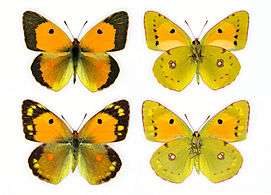Colias croceus
| Clouded yellow | |
|---|---|
_male_underside_2.jpg) | |
| male | |
_female_underside.jpg) | |
| female both, Old Winchester Hill, Hampshire | |
| Scientific classification | |
| Kingdom: | Animalia |
| Phylum: | Arthropoda |
| Class: | Insecta |
| Order: | Lepidoptera |
| Family: | Pieridae |
| Genus: | Colias |
| Species: | C. croceus |
| Binomial name | |
| Colias croceus (Geoffroy, 1785) | |
| Synonyms | |
|
Colias crocea | |
Colias croceus is a small butterfly of the Pieridae family, that is, the yellows and whites. In India and nearby regions it is known as the dark clouded yellow or common clouded yellow to distinguish it from the other species of clouded yellows occurring there; elsewhere it is often simply known as the clouded yellow, as it was the first and original butterfly to go by this name.
Description
The upperside is golden to orange yellow with a broad black margin on all four wings and a black spot near the centre forewing. The underside lacks the black borders and is lighter, with a more greenish tint, particularly on the forewings. In the forewing underside is the same dark spot as on the upperside, but often with a light centre; the hindwing underside has a white centre spot, often with a smaller white or dark dot immediately above it. Sometimes, a row of black dots occurs on the underwings' outer margins, corresponding to where the black border ends on the upperside,
Females differ from the males in having yellow spots along the black borders on the upperside. In a small proportion of females the golden upperside colouration is replaced by a pale cream colour. These have been distinguished as form helice, but do not seem to be that distinct as intermediates exist and the variation is to some extent related to humidity during development, with dryer conditions producing paler colouration.
In flight, it is easily identifiable by the intense yellow colouring, much brighter than that of the lemon-yellow male common brimstone which also lacks black colour. Like all Colias species they never open their wings at rest. Pale females can be confused with the rarer pale clouded yellow (C. hyale) and Berger's clouded yellow (C. sareptensis). Even the palest C. croceus tends to have more black on the upperside however, in particular on the hindwings.
 Male dorsal side
Male dorsal side Female form helice
Female form helice Male (top) and female (bottom)
Male (top) and female (bottom)
Distribution and ecology
The common clouded yellow's breeding range is North Africa and southern Europe and eastwards through Turkey into the Middle East but it occurs throughout much of Europe as a summer migrant, in good years individuals reaching Scandinavia. In Asia, its range extends into central Siberia in the north and barely into India in the south; it is not found in Central Asia. In the UK they can be seen on the south coast almost every year in varying numbers, and regularly breed there. Occurrence in the rest of the UK varies considerably from year to year, but they are increasingly observed as far north as Dumfries and Galloway.
It has also been recorded in Ireland from the Raven, Co. Wexford.[1]
A truly migratory European butterfly, this species is famous for occasional mass migrations and subsequent breeding, which are often referred to in the United Kingdom as "clouded yellow years". Notable clouded yellow years include 1877, 1947, 1983, 1992, 1994, 1996 and 2000.
Life cycle and larval host plants
In southern Europe and North Africa they breed continuously throughout the year. Eggs are laid singly on food plant leaves. The caterpillars grow fast in warm weather, sometimes pupating within a month. Pupation lasts for two or three weeks and in good years there can be as many as three generations per year, with adults still on the wing at the beginning of November.
Common clouded yellows feed on a variety of leguminous plants, namely Faboideae. In the UK wild and cultivated clovers (Trifolium) and alfalfa (Medicago sativa) are favourites; less frequently, common bird's-foot trefoil Lotus corniculatus is eaten.
See also
References
- ↑ Walsh, F. and Walsh, M. 2014. The Clouded Yellow butterfly Colias croceus (Fourcroy) overwintering at the Raven, Co. Wexford in Ireland. Ir Nat. J. 33: 89 - 92
| Wikimedia Commons has media related to Colias croceus. |
- Asher, Jim; Warren, Martin; Fox, Richard; Harding, Paul; Jeffcoate, Gail & Jeffcoate, Stephen (2001): The Millennium Atlas of Butterflies of Britain and Ireland. Oxford University Press. ISBN 0-19-850565-5
- Evans, W.H. (1932). The Identification of Indian Butterflies (2nd ed.). Mumbai, India: Bombay Natural History Society.
- Wynter-Blyth, Mark Alexander (1957). Butterflies of the Indian Region. Bombay, India: Bombay Natural History Society. ISBN 978-8170192329.
External links
- C. croceus images at Consortium for the Barcode of Life
- BMNH images of named aberrations in the Cockayne collection